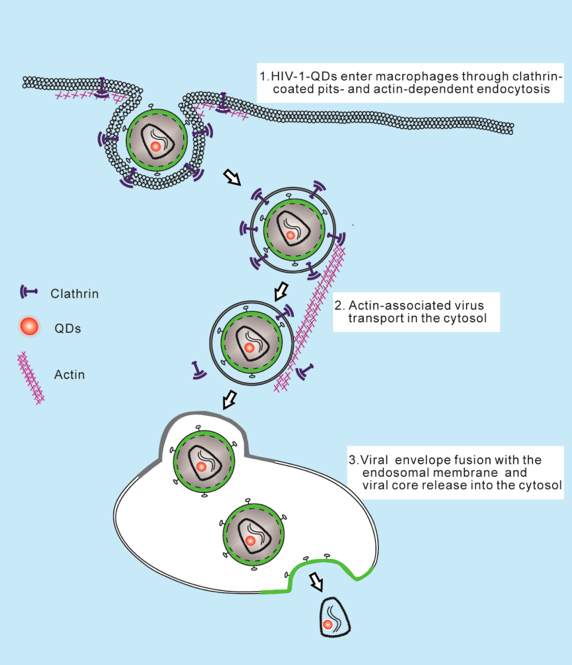As one of the major targets of human immunodeficiency virus (HIV-1), macrophages (a type of white blood cell) play an important role in HIV infection. However, how the virus enters the macrophages is still poorly understood. In present study, Prof. CUI Zongqiang from Wuhan Institute of Virology of the Chinese Academy of Sciences, Prof. ZHANG Xian’en from Institute of Biophysics of the Chinese Academy of Sciences, and Prof. WU Yuntao from George Mason University have now constructed a quantum dot (QD)-encapsulated infectious HIV-1 particle to observe the viral entry pathway to the macrophages at a single-particle level in live cells. The technique may assist in the development of inhibitors to block the HIV entry in macrophages.
Single-particle tracking is a powerful technique for studying viral entry, and inorganic semiconductor nanocrystal QDs are suitable for imaging single particles and tracking viral infection in live cells thanks to their remarkable brightness and the fact that they are photostable over time. The researchers have now used a technique called cell-assisted assembly to construct QD-encapsulated infectious HIV-1 particles that can be tracked in real time using florescence imaging. QDs were encapsulated in HIV-1 virions by incorporating viral accessory protein Vpr-conjugated QDs during virus assembly.
Prof. CUI and the colleagues monitored the early phase of viral infection in real time by using the HIV-1 particles encapsulating QDs. They observed that, HIV-1-QDs enter macrophages through clathrin-coated pits and actin-dependent endocytosis; endosome fusion is proved to be critical for HIV-1 productive infection in primary macrophages by a series of drug inhibition experiments. Additionally, they found that a dynamic actin cytoskeleton serves a vital role in HIV-1 entry in macrophages.
The researchers say that their findings may help to develop inhibitors to stop the HIV entry in macrophages, which may provide some new thoughts to the antiviral drugs development. These results have been published in ACS Nano entitled "Single-Particle Tracking of Human Immunodeficiency Virus Type 1 Productive Entry into Human Primary Macrophages". The research team also includes scientists from Huazhong University of Science and Technology in Wuhan.
This work was supported by the National Key Research and Development Program of China, the National Natural Science Foundation of China (NSFC), the CAS Key Program and the CAS Youth Innovation Promotion Association.

Mechanism for HIV-1 productive entry into primary macrophages revealed by single-particle tracking. Image by CUI Zongqiang
Contact:
CUI Zongqiang
E-mail: czq@wh.iov.cn
Wuhan Institute of Virology, Chinese Academy of Sciences, Wuhan, Hubei, People's Republic of China
(http://english.whiov.cas.cn/)